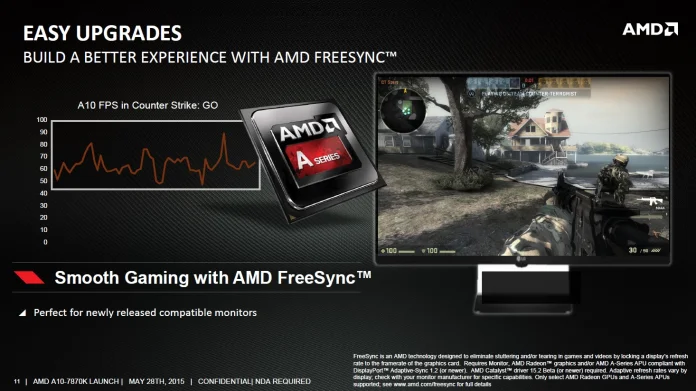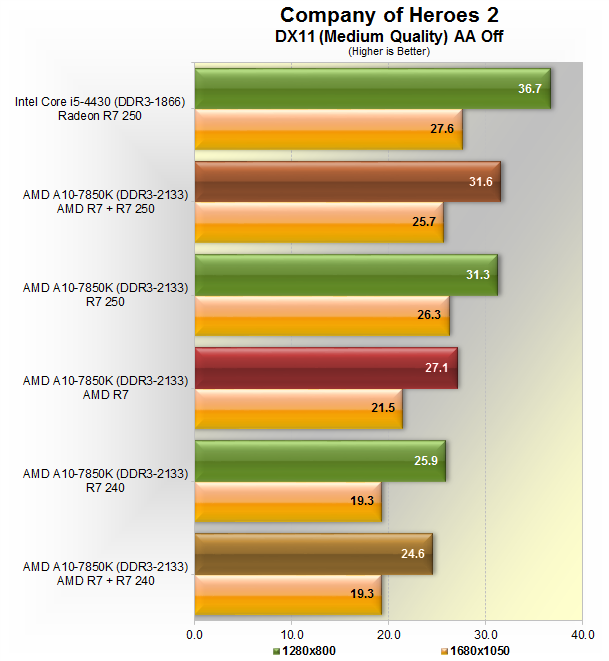After an extended period of hardware silence, AMD has recently made its resurgence with updated GPU and CPU lines. The Radeon 300 series refreshed the existing R200 lineup, followed shortly by the architecturally revamped Fiji GPU on the Fury X; we've reviewed both of these launches (R9 390 & 380 review / Fury X review). Back in May, we also posted about the company's promised Kaveri refresh – the A10-7870K – and its market positioning.
- Amd A10 7870k Release Date
- Amd A10 Vs Intel I7
- Amd A10 Vs Intel I5
- Amd A10 7850k Dual Graphics Compatibility List
- Amd A10 7870k Dual Graphics Compatibility Download
Today we're reviewing that APU.
If someone could find me a list of all the discrete graphics cards that are compatible with the AMD A10 7850k apu processor in dual graphics mode that would be appreciated. Not actual individual cards but what R7s are able to run 'essentially' in crossfire with the A10s integrated graphics. Dual-channel (2× 64 Bit) DDR3 memory controller. Integrated custom ARM Cortex-A5 co-processor with TrustZone Security Extensions in select APU models, except the Performance APU models. Select models support Hybrid Graphics technology by using a Radeon R7 240 or R7 250 discrete graphics card. Based on 130,146 user benchmarks for the AMD A10-7870K APU (2014 D.Ka) and the Ryzen 3 2200G, we rank them both on effective speed and value for money against the best 1,276 CPUs. Same socket AMD A10-7890K is an upcoming AMD Accelerated Processing Unit for socket FM2+ platform. It is rumored to replace the A10-7870K, which is a current AMD flagship APU. Partial specifications of the A10-7890K. Dual Graphics - R7 250. I suggest DDR3 equipped models. No desktop APU can work in Dual Graphics with desktop R7 360. Support for USB 3.1 an M.2 is a motherboard feature - put the APU in suitably equipped mobo to get those features. It is not dependent on the processor.
The A10-7870K APU is built on the Kaveri architecture and refreshes the A10-7850K, mostly by way of small frequency boosts to the CPU and GPU. This AMD A10-7870K review compares the APU against budget CPU + GPU purchases – like the G3258 – and Intel's own HD 4000 series IGPs.
AMD's A10-7870K is priced at $150 at most retailers. Note that, at the time of this review, Amazon is selling the A10-7870K for $122 as a “daily deal.” Pricing will return to $150 once the day has concluded.
We understand that AMD's market positioning and target may differ in Asiatic countries. This review strictly looks at the product from a US / Western perspective, where the price structure of competing and ancillary products is more familiar.
AMD A10-7870K Specs
| A10-7870K | A10-7850K | A10-7700K | |
| COMPUTE Cores | 4 CPU + 8 GPU | 4 CPU + 8 GPU | 4 CPU + 6 GPU |
| Frequency | 4.1 / 3.9GHz | 4 / 3.7GHz | 3.8 / 3.4GHz |
| L2 Cache | 4MB | 4MB | 4MB |
| GPU Frequency | 866MHz | 720MHz | 720MHz |
| Feature Support | Dx12, HSA, FreeSync, Unlocked | Dx12, HSA, FreeSync, Unlocked | Dx12, HSA, FreeSync, Unlocked |
Changes from the A10-7850K
The A10-7870K reflects similar feelings to the R300 refresh. It's not a new architecture, but there are some small changes instituted to the existing platform. As with the R300 vs. R200 references, we would consider the 7870K a “refresh” to the 7850K; that is, it's not a true “rebadge” – the selling of an existing product under a new name – but isn't entirely new, either. There is no inherent flaw with refreshing a product as long as the new price and feature updates reflect progress. Most companies, even non-electrical manufacturers (like those who make cases and coolers), will refresh products between cycles.

AMD's 7870K has increased the CPU frequency from 4GHz / 3.7GHz (turbo / standard) on the 7850K to 4.1GHz / 3.9GHz (turbo / standard) on the 7870K; that's a 0.2GHz pre-overclock. The GPU frequency is slightly more noteworthy, increasing from 720MHz to 866MHz. The rest is the same – Dx12, HSA, and FreeSync are all supported on both the 7850K and 7870K. The 7870K still hosts 4 CPU and 8 GPU cores.
AMD's Kaveri platform hosts Steamroller, for those who recall the now-aging Bulldozer / Piledriver / Steamroller nomenclature. The architecture remains heavy on COMPUTE and arithmetic (integer) processing. Steamroller drove IPC performance more heavily than its power-focused predecessor, Piledriver. Kaveri hosts 2.41B transistors on a 245mm^2 physical die package, using 28nm manufacturing process.
Kaveri's programming model allows developers to tap into its heterogeneous system architecture (HSA) for more equal loading of the coupled CPU and GPU components. The CPU and GPU are able to jointly access most sets of data in the same memory locations, theoretically allowing for co-processing in a fashion that accelerates applications. This is something that must be optimized for in the codebase and is not necessarily a “free” performance improvement.
Test Methodology
We tested using our updated 2015 GPU test bench, detailed in the table below. Our thanks to supporting hardware vendors for supplying some of the test components.
Amd A10 7870k Release Date
The latest AMD Catalyst drivers (15.7.1) were used for testing. NVidia's 353.62 drivers were used for testing. Game settings were manually controlled for the DUT.
Testing was split between CPU bottleneck analysis and IGP benchmarks. To test at what point the CPU bottlenecks a high-end GPU, we equipped all platforms with a GTX 980 Ti and performed tests using the following settings:
- Metro: Last Light - Very High w/ high tessellation.
- GRID: Autosport - Ultra, 4xMSAA.
- Shadow of Mordor - Ultra preset.
- GTA V - Very High / High.
- GTA V - Very High / High with Advanced Graphics (to find bottlenecks).
- FireStrike (normal).

IGP testing was performed with a lower-end set of games due to limitations on the on-die GPU:

- CSGO - High / Very High with AA disabled.
- GRID: Autosport - Medium.
- DOTA2 - Medium on the sliders, other settings as below.
- GTA V - Lowest (normal).
- FireStrike (normal) for physics.
All tests had the resolution set to 1080p.
Each game was tested for 30 seconds in an identical scenario, then repeated three times for parity.
Amd A10 Vs Intel I7
Average FPS, 1% low, and 0.1% low times are measured. We do not measure maximum or minimum FPS results as we consider these numbers to be pure outliers. Instead, we take an average of the lowest 1% of results (1% low) to show real-world, noticeable dips; we then take an average of the lowest 0.1% of results for severe spikes. Anti-Aliasing was disabled in all tests except GRID: Autosport, which looks significantly better with its default 4xMSAA. HairWorks was disabled where prevalent. Manufacturer-specific technologies were used when present (CHS, PCSS).
Amd A10 Vs Intel I5
Here is the Intel test bench:
| GN Test Bench 2015 | Name | Courtesy Of | Cost |
| Video Card | GTX 980 Ti | NVIDIA AMD | - |
| CPU | Intel i7-4790K CPU Intel i5-4690K CPU Intel i3-4160 CPU Intel G3258 CPU | CyberPower GamersNexus GamersNexus GamersNexus | - |
| Memory | 16GB 2133MHz HyperX Savage RAM | Kingston Tech. | $300 |
| Motherboard | Gigabyte Z97X Gaming G1 | GamersNexus | $285 |
| Power Supply | NZXT 1200W HALE90 V2 | NZXT | $300 |
| SSD | HyperX Predator PCI-e SSD | Kingston Tech. | TBD |
| Case | Top Deck Tech Station | GamersNexus | $250 |
| CPU Cooler | Be Quiet! Dark Rock 3 | Be Quiet! | ~$60 |
Amd A10 7850k Dual Graphics Compatibility List
And the AMD bench:
Amd A10 7870k Dual Graphics Compatibility Download
| GN Test Bench 2015 | Name | Courtesy Of | Cost |
| Video Card | GTX 980 Ti | NVIDIA AMD | - |
| CPU | AMD A10-7870K AMD Athlon X4 760K | AMD GamersNexus | - |
| Memory | 16GB 2133MHz HyperX Savage RAM | Kingston Tech. | - |
| Motherboard | ASUS A88X-PRO | GamersNexus | $285 |
| Power Supply | NZXT 1200W HALE90 V2 | NZXT | $300 |
| SSD | HyperX Savage SSD | Kingston Tech. | TBD |
| Case | Top Deck Tech Station | GamersNexus | $250 |
| CPU Cooler | Be Quiet! Dark Rock 3 | Be Quiet! | ~$60 |
Continue to page 2 for the benchmark results!
